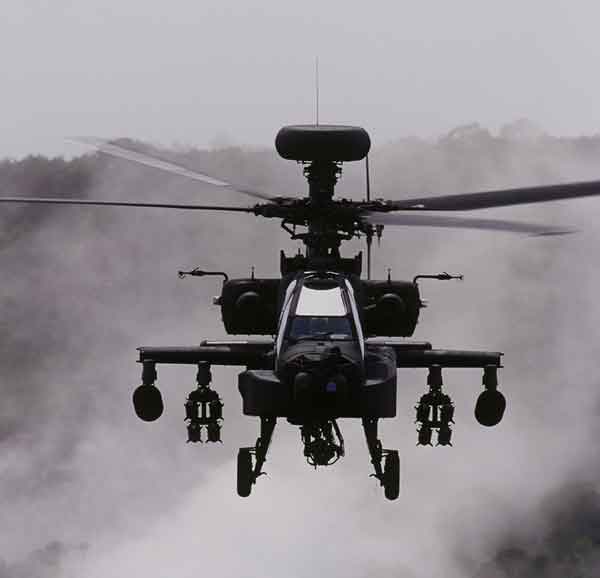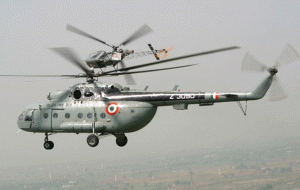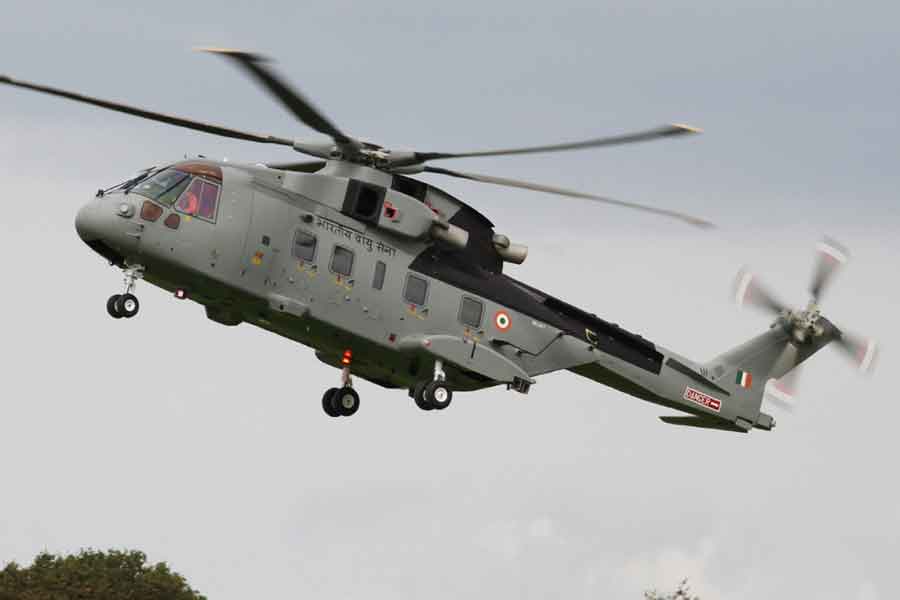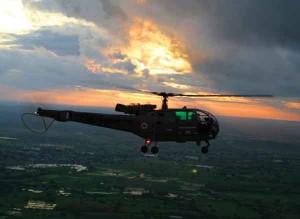The Helicopter in Battle
The two widely disparate views cited above on the utility of the helicopter have influenced the use of this versatile platform in military operations. Any discussion on the applications of the helicopter in combat brings back memories of the Bell 47 seen at the beginning of every episode of the popular TV serial M.A.S.H ferrying wounded soldiers to a field hospital in the Korean War, of swarms of Huey UH-1H helicopters landing combat troops in the open fields in Vietnam, of Russian Mi-24 attack helicopters in Afghanistan and downing of two American helicopters in Somalia in the movie Black Hawk Down.
The first reported use of helicopters in combat was during World War II where they were used in light utility roles including search for submarines. The technology was not refined adequately to bring Allied or German helicopters into combat roles, however American helicopters came under fire for the first time in WW II when they were used to evacuate battle casualties from the front line in Luzon, Philippines to hospitals in the rear.
The Vietnam War was the litmus test for helicopters in combat. The operational roles of the helicopter were exploited to the fullest and new tactics evolved as the war progressed.
In the late forties after World War II, the US Marines claimed having pioneered the concepts of vertical envelopment, assault troop mobility and logistical re-supply with the helicopter. A tactical nuclear engagement in Europe as envisaged in the post WWII era, demanded rapid dispersion of attacking forces to make them less vulnerable. Ship- borne and land-based helicopters offered a viable option. The Korean War was the test bed for these concepts. The Bell S-47 and Sikorsky S-51 were used extensively for utility, rescue and medical evacuation. The Sikorsky S-51 was capable of carrying two pilots and a passenger and the Bell S -47 carried one pilot and two passengers in a bubble cockpit. The Bell helicopter was modified to carry two stretchers on the skids outside the cockpit.
In the bitter cold of the Korean winter, it could not have been comfortable but was infinitely more welcome than a bumpy road journey to a field hospital. The first US Marine helicopter re-supply mission in the Korean War flew on September 13, 1951. Eight days later, 224 US Marines and 17000 pounds of cargo were landed on an isolated hilltop. The doctrine and tactics developed by the US Marines after WW II were proven in the Korean War and the helicopter emerged a clear winner. A Marine operational report stated “ The initial efforts have stated strikingly the great contribution to tactical and logistical flexibility that the assault helicopter offers. Helicopter functions will be progressively enlarged as time passes and the aircraft type must be recognised as a requisite component of a balanced military force.”
The Vietnam Experience
The Vietnam War was the litmus test for helicopters in combat. The operational roles of the helicopter were exploited to the fullest and new tactics evolved as the war progressed. Unlike in Korea where helicopters operated from a clearly defined front-line, in Vietnam, the Bell Huey UH-1H with Red Cross markings flew into combat zones to pick up casualties. Unarmed helicopters were also used to deliver supplies and ammunition to troops and these missions were lightheartedly termed as “ preventive medicine”.
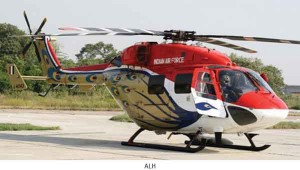 As the war progressed, the North Vietnamese refined their tactics against helicopters and inflicted heavy losses on US helicopters which had to be provided with armour plating for the crew and engines for protection against small arms fire. US Helicopters were also equipped with missile launch warning systems, flare dispensers and engine exhaust heat suppression systems to degrade enemy air defence artillery and surface to air missiles. Though the helicopter was better protected, they continued to be vulnerable to ground fire. The last poignant image of the Vietnam War was of a US Marine helicopter hovering above the US Embassy in Saigon to evacuate the last few Americans.
As the war progressed, the North Vietnamese refined their tactics against helicopters and inflicted heavy losses on US helicopters which had to be provided with armour plating for the crew and engines for protection against small arms fire. US Helicopters were also equipped with missile launch warning systems, flare dispensers and engine exhaust heat suppression systems to degrade enemy air defence artillery and surface to air missiles. Though the helicopter was better protected, they continued to be vulnerable to ground fire. The last poignant image of the Vietnam War was of a US Marine helicopter hovering above the US Embassy in Saigon to evacuate the last few Americans.
The Vietnam War saw the role of the helicopter enlarged to include such diverse missions as heavy lift, mine countermeasures, combat search and rescue, special operations, psychological warfare, assault operations, tactical recovery of aircraft etc. Of the over 40,000 helicopter pilots and crew that served in the Vietnam War, more than 4900 perished. Also, over 4000 of the 12000 helicopters deployed in Vietnam were lost. The sheer magnitude of helicopter operations in Vietnam is unlikely to be surpassed ever. Helicopters changed the way ground wars had been fought.
…over 4000 of the 12000 helicopters deployed in Vietnam were lost. The sheer magnitude of helicopter operations in Vietnam is unlikely to be surpassed ever.
Instead of armies engaging one another on static fronts or advancing slowly and holding ground, helicopters gave commanders the ability to move troops quickly into hostile territory, to deploy and withdraw as required. The Huey UH-1H became symbolic of the Vietnam War and was as ubiquitous as the Willy’s Jeep in World War II.
The European Theatre
As the Vietnam War was winding down, the focus shifted to Europe where the standing armies of NATO and Warsaw Pact countries were pitted against each other. The threat of a Soviet led ground offensive loomed large and air mobility offered some solutions to NATO. The overwhelming Warsaw Pact ground forces and their manoeuvre capability was planned to be blunted by the superior technology of NATO forces. By the eighties, heavily armed helicopters with missiles were being touted as tank busters. The Warsaw Pact air defence environment in Europe appeared to be invincible and was a serious threat to NATO helicopters.
NATO strategy emphasised night operations using leading edge technologies for navigation, target acquisition, night vision devices for aircrew and ultra low level flying using “ Nape of the Earth” flying techniques but none of these were tested in combat. These technologies were being developed both by NATO forces and the Soviet Union and fielded by their respective armies; but the overall strategy in Europe was tempered with caution as both sides knew that any misadventure could quickly escalate into a tactical nuclear war or worse.
War in Afghanistan
The Soviet invasion of Afghanistan provided the next opportunity to evaluate the effectiveness of helicopters in combat. On December 25, 1979, Soviet airborne troops landed at Kabul to form an air-bridge and two days later, Soviet ground forces entered Afghanistan. President Hafizullah Amin was assassinated and replaced by Babrak Karmal. During the decade long Soviet expedition in Afghanistan, sometimes referred to as the “Russian Vietnam”, helicopters were the mainstay of the Soviet forces and were used in every conceivable role. The Mi-17 gunship and the Mi-24/35 attack helicopter established the efficacy of the combat helicopter as an airborne platform to provide extended support to ground forces. Attack helicopters were employed to protect assault troops, escort convoys, undertake hunter-killer missions and night operations lighting up areas of action with flares.
…lessons from the wars of the past and ongoing conflicts around the world indicate that there could be serious constraints on the use of gunships and attack helicopters in the high altitude regions of the Himalayas.
In the early days of the war, the Afghan rebels were armed with only heavy machine guns, rocket propelled grenades and some rudimentary and ineffective air defence artillery. Against an ill-equipped opposition, Russian pilots recorded a high degree of success. As the CIA supplied Stinger missiles arrived in Afghanistan, attrition rate of Russian helicopters climbed significantly. As the Russian helicopters were compelled to operate outside the kill envelop of the Stinger missile, they were relatively less effective. The lesson that even combat helicopters were highly vulnerable in a lethal air defence environment was reiterated.
The Indian Experience
The Indian experience of helicopters in combat roles is perhaps based on experiences during the 1962 war with China, the 1965 and 1971 wars with Pakistan and in 1987-88 while operating as part of the Indian Peace Keeping Force (IPKF) in Sri Lanka. The final assault on Dhaka in December 1971 could not have been carried out if it was not for the airlift of troops by Indian Air Force (IAF) helicopters across the innumerable water obstacles in East Pakistan, later Bangladesh.
The Gulf Wars
Operation Desert Storm, invasion of Iraq by the US-led coalition forces commenced on January 17, 1991 when eight Apache AH-64 attack helicopters supported by four Sikorsky MH-53 Pave Low III punched a hole in the Iraqi radar network through which fighters could fly with impunity.
During the ground war lasting 100 hours, 277 Apache AH-64 helicopters took part, destroyed over 500 tanks for the loss of a lone helicopter destroyed by a rocket propelled grenade. The US-led coalition in 2003 was not as fortunate. On March 24, 2003, the US 3rd Infantry Division launched a night attack on the Republican Guard Brigade deployed in depth to the West of Karbala. 31 Apache helicopters departed for the mission one of which crashed immediately after takeoff.
The mission was lured into a trap and one helicopter was shot down over target area. Of the remaining 29, all but one were seriously damaged by ground fire forcing a hasty retreat. After the mission, the squadron was left with just a single machine fit to undertake operations. The disaster put an end to the concept of committing sophisticated attack helicopters for deep strike in Iraq. Tactics in vogue were reviewed and changed thereafter. Subsequent reports attributed the disaster to compromised intelligence and stringent rules of engagement.
Helicopters will remain key weapon system in future wars. The success of helicopter operations will however hinge on the integration of the helicopter and fixed wing air campaign plans…
It was reported that Signal Intelligence picked up over 50 cell phone calls warning the Iraqi forces of the advancing helicopter armada. The attack helicopters were restrained from responding to ground fire from buildings to obviate the risk of collateral damage to civilian population. In intervening years since the first Gulf War, the environment for helicopter operations had changed immensely. However, attack helicopters are still being used by the International Security Assistance Forces in Afghanistan where they continue to sustain damage from ground fire.
The Helicopter in Future Conflicts
In all the wars from the US involvement in Vietnam in the fifties to the invasion of Iraq in 2003 and the ongoing operations by the ISAF in Afghanistan, helicopters have played a major role. However, their effectiveness has has often been eroded by the lethality of the enemy air defence system. The phenomenal success of helicopter operations in Vietnam is eclipsed by the current assessment of the vulnerability of helicopters to ground fire particularly in mountainous terrain, in desert areas and in urban warfare.
The success in Vietnam can be attributed to an extent to the limitations of the North Vietnam arsenal, immunity from ground fire while flying above dense forests and the overwhelming numbers committed by the US. The helicopters of that era were comparatively easy to repair and maintain in the combat zone, whereas modern helicopters are highly sophisticated, carry space age technology and need elaborate maintenance support. Unit cost of helicopters have also escalated exponentially thus reducing substantially the numbers available for deployment.
Future wars are likely to witness helicopters being employed extensively in the combat zone but whether they will be used for offensive missions or in supporting roles will depend on the environment in which they are deployed. The Indian Army doctrine envisages a two-front war i.e. simultaneous conflict against China and Pakistan. In addition the Indian Armed Forces perceive for itself tasks such as strategic operations transcending national boundaries, asymmetric operations and sub-conventional threats which could include counter insurgency. However, lessons from the wars of the past and ongoing conflicts around the world indicate that there could be serious constraints on the use of gunships and attack helicopters in the high altitude regions of the Himalayas.
The air defence environment in the desert areas across India’s Western borders, is well equipped to deal with low speed flying machines such as helicopters. Combat operations by helicopters therefore would have to be in synergy with combat missions by the fixed wing aircraft of the IAF. Helicopter operations therefore would have to be dovetailed into the air campaign from the initial planning stage itself. Fratricide in close combat has to be avoided at all cost and helicopters have to train to fight in coordination with fighter aircraft and aerial drones.
The Eastern front against China is a different environment. The access routes into India are well defined and do not lend themselves to manoeuvre warfare by the enemy. The terrain poses serious problems to fixed wing aircraft in providing support to own ground forces and helicopters will be ideally suited to provide combat, logistic and communication support. In the India-Pakistan or India-China context the use of fixed wing fighters in a conflict situation would be seen as escalatory inclined to push the adversary to the next level of conflict; but the use of combat helicopters may not have the same effect. Any Indian expeditionary force operating “out of theatre” would need helicopter support for a number of roles as own combat air support is unlikely to be available. Experience also shows that helicopters will be an essential part of any force earmarked for sub-conventional threats and counter-insurgency operations.
If the helicopter is to be an effective combat platform in future wars, and evolve new techniques to counter current and future threats need to be evolved based on lessons from previous wars.
Modern helicopters have a variety of systems, weapons, mission capability and on-board technology. However, experience in conflicts in the recent past indicates that despite protective measures, helicopters are vulnerable to ground fire. If the helicopter is to be an effective combat platform in future wars, and evolve new techniques to counter current and future threats need to be evolved based on lessons from previous wars. Depending purely on emerging technologies to throw up solutions will be counter productive as the success of helicopter missions will be influenced by the operating environment. Helicopters will remain key weapon system in future wars. The success of helicopter operations will however hinge on the integration of the helicopter and fixed wing air campaign plans, supported by the capability of the operating crew to innovate tactics, and the competence of the staff to mix and match the capability of the helicopter fleet to the threats at hand.
A balanced air force must have the capability to fight across the full spectrum of conflict and helicopters are an essential part of that force and their use in combat is only limited by one’s imagination. The modern military helicopter is equipped with state-of-the-art electronics for acquiring targets, identification and their destruction by day or night. It has armour protection for the crew and vital components of the machine, electronic warfare suites for offensive and defensive counter-measures, damage resistant engines and a host of other combat enhancement systems which the manufacturers claim, make it invincible on the battle field. Unfortunately, like the Biblical story, ill-equipped Davids of the world with low grade technology weapons bring down these Goliaths from time to time, and that is the dilemma that faces military planners.




